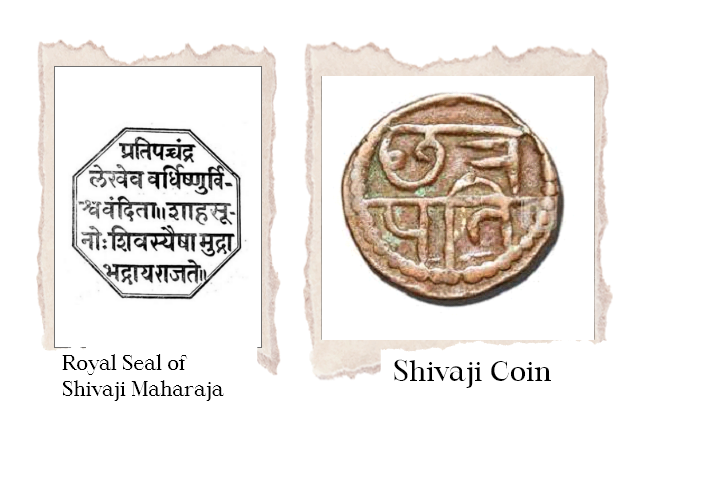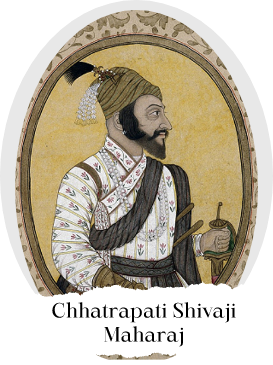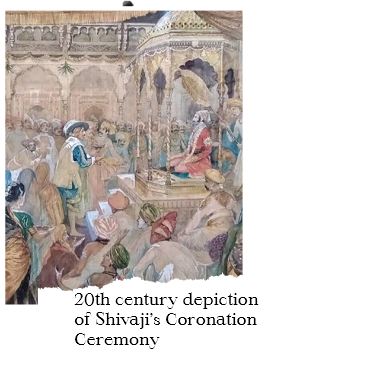The ideal of the Maratha State (Swarajya) & Kingship
In 1674, Shivaji crowned himself at Raigad and a new era called the ‘Rajyabhisheka
Era’ commenced in the history of India. Shivaji wanted to completely separate from
the Mughal Empire, therefore he commissioned new coinage and regal insignia. Shivaji
took administrative ideas from ancient Indian political writers as he consulted
Mahabharata and Sukraniti and found that government should be vested in the hands of
a council of ministers. The formation of a council of eight ministers popularly
known as Ashtapradhdna by Shivaji and giving them Sanskrit designations, indeed, was
part of his endeavour to revive ancient Hindu political institutions.
[7]
But his real genius of practical statesmanship lay in the manner in which he
successfully blended ancient Indian political institutions with his contemporary
administrative machinery and devised a novel system of administration suited to his
times and his people. Overall, the ancient Indian aphorism that the ruler is the
marker of his age found expression in Shivaji’s idea of kingship.[8]
Contemporary writers considered Shivaji Maharaj an avatar (incarnation) and saw a
divine hand in the foundation of Swarajya.[9] We can well understand
their feelings, considering the almost miraculous achievements of Shivaji. But
curiously enough, even the contemporary foreign accounts lend support to the avatar
theory when they speak of Shivaji in superhuman terms.[10]
The foundation of the Maratha State by Shivaji was a great manifestation of a true
national spirit embodied in the concept of Hindavi Swarajya. Maharashtra during
those times saw many saints from all castes like Shri Chakradhar, Namdeo,
Dnyaneshwar, Eknath, Tukaram, Janabai, and Samarth Ramdas (the guru of Shivaji).
These saints brought great social and spiritual awakenings and produced a new spirit
of democratic equality and homogeneity among the people of Maharashtra. Thus Shivaji
was not only inspired by the teachings of great Maharashtra saints but his quest for
Swarajya was also aided by the widespread spiritual and social enlightenment sparked
by these saints. Shivaji’s teacher, Ramdas gave a religio-political colour to the
Maratha's aspiration of an independent state.[11] Thus, Shivaji came up
as Protector of Dharma (Righteousness) and welded Maratha territory into a single
body politic (Swarajya) on the principal of social harmony and welfare of peasants.
It was Dharma, which formed the root of his Swarajya. It was also his firm belief
that his kingdom was divinely ordained and he used his royal authority for the
well-being of his people.
In an age of bigotry and ruthlessness, he threw careers open to talent and provided
patronage and safety for all of his subjects. In his Swarajya, the welfare of the
peasantry was greatly emphasised. As landlords were often unjust to the cultivators,
he kept them under strict control and he did not create any middlemen between the
government and the tillers of the soil. Shivaji’s letter dated April 1673 addressed
to his administrative and revenue officers speaks volumes about his concern for the
common folk in his country. He writes in this letter:
If you rob the poor cultivators of their grain, bread, grass, fuel or
vegetables, they will find life impossible and run away. Many will die of
starvation. Then they will think that you are worse than the Mughals who overrun
the countryside. Know this well and behave yourself. You have no business to
give the slightest trouble to the ryots. Whatever you want - whether grain,
grass, fuel, vegetables or other provisions — you should purchase it in the
bazaar. There is no need for you to force anybody or to quarrel with
anybody. [12]
His subjects regarded him as their liberator, emancipator, and
protector.[13] The unbounded admiration that the masses had for their
beloved hero constituted Shivaji’s real strength in founding Swarajya.
Ramchandrapant Amatya, who served as the Finance Minister to Shivaji accurately,
reflects the political mind of his Chhatrapati (emperor) in his Adnyapatra (the
formal documentation of Shivaji’s ideals, principles, and policies of state
administration).[14] He provides us with a clear idea of the essential
features of the grand polity of Swarajya. The cardinal principles of Shivaji’s
administration of Swarajya were:
- To promote the well-being of his people and the general welfare of the State.
- To maintain an efficient military force to defend Swarajya.
- To provide adequately for the economic needs of the people by encouraging
agriculture and industry.[15]
Administrative Divisions
The kingdom was divided into Subhas, Sarkars, Parganas, and Maujas both in the Mughal
Empire and the Deccan states. Shivaji replaced this division with Prants, Tarafs,
and Maujas. But the old nomenclature continued to be used for a long time, hence
there is much confusion in identifying territories. There were twelve Prants under
Shivaji. Whereas, civil territory held under the direct sway of Shivaji, was divided
into seventeen districts. Each Prant was put under a Subedar and a Karkun, while the
Taraf was governed by a Havaldar. Shivaji gave Sanskrit names to Subedar and
Sarsubedar who were called Deshadhikari and a Mukhya-Deshadhikari, while the Karkun
and Sarkarkun were named Lekhak and Mukhya-Lekhak (however, the official letters
also carry the old Persian names probably because Sanskrit names did not become
popular.). A few villages were put under the charge of a Kamavisdar. Each Subedar
had generally eight assistants in charge of various duties. They were Dewan,
Muzumdar, Fadnis, Sabnis, Karkhanis, Chitnis, Jamadar and Potnis.[16] The
administrative division can thus be represented as:
Council of Eight Ministers: Ashtapradhdna
Shivaji threw careers open to talent and built up small men to achieve great deeds.
Therein lay his genius as an administrator. Moro Pant Pingle, a family priest
becomes his Prime Minister; Annaji Datto, a village accountant rise to be his
Finance Minister. The men trained by Shivaji faced the greatest generals in battle
and the greatest statesmen in diplomacy. Sonaji Pant Dabir negotiated with Aurangzeb
and Sundarji Prabhu with the English. Prahlad Niraji was the Maratha envoy at the
court of the Qutb Shah. Shivaji aimed at giving equal opportunities for all castes
and creeds in his system of administration. Thus, fully acknowledging the importance
of ministers (Pradhans) in conducting the affairs of the kingdom as recommended in
the ancient Sastras, Shivaji and his mother Jija Bai as early as 1642 appointed
Shamraj Nilkanth Ranzekar as Peshwa, Balkrishna Pant Hanumante as Mujumdar, Sono
Pant as Dahir and Raghunath Ballal as Sabnis. This was the nucleus of what later
developed into the famous Council of Eight Ministers called Ashtapradhdna.
[17]
This Council of eight ministers, Ashtapradhdna acted as Shivaji’s secretaries and
their function was purely advisory. These ministers mainly supervised the details in
their respective departments. It is to be noted that Shivaji never interfered with
the ecclesiastical and accounts departments. Shivaji also specified the duties of
his eight ministers and other departmental heads. It is worth mentioning here that
his Ashtapradhdna was basically a portfolio system based on Sukraniti (ancient
treatise on the science of governance). The names and duties of ministers were
largely adopted from Sukra’s Polity only.[18] The eight ministers and
their duties were the following: [19]
-
Peshwa or Mukhya Pradhan (Prime Minister): He was in charge of the whole
administration of the kingdom. He was to work with the counsel and
cooperation of his colleagues. In times of war, he was to bravely lead the
army, subjugate new kingdoms and make necessary arrangements for the
administration of the newly-acquired territories. All state papers and
charters had to bear his seal below that of the king.
-
Amatya or Majumdar (Finance Minister): He had to check all the accounts of
public income and expenditure and report them to the king, and countersign
all statements of accounts both of the kingdoms in general and of the
particular districts.
-
Mantri or Waqianavis (Political secretary): His duties were to compile a
daily record of the king's doings and court incidents, and to watch over the
king’s invitation lists, meals, and companions, , to guard against murderous
plots. The invitation and intelligence departments were under him. He was
also to serve in the war. His seal was to be put on official documents.
-
Sachiv or Shurunavis (Superintendent): He had to see that all royal letters
were drafted in the proper drafted. He had also to check the accounts of the
mahals and parganas.
-
Sumant or Dabir (Foreign Secretary): He was the king's adviser on relations
with foreign States, war, and peace. It was also his duty to keep
intelligence about other countries, to receive and dismiss foreign envoys,
and maintain the dignity of the State abroad. He was to receive and
entertain foreign envoys and maintain the dignity of the state abroad.
-
Senapati or Sar-i-Naubat (Commander-in-chief): He maintains the army, makes
war, and leads expeditions. He should preserve the newly-acquired
territories, render an account, report to the king the requirements and
grievances of the army, and obtain lands and rewards for the meritorious.
-
Pandit Rao and Danadhyakska (The ecclesiastical head): It was his function to
honour and reward learned Brahmans on behalf of the king, to decide
theological questions, to fix dates for religious ceremonies, to punish
impiety and heresy, and order penances. He was a Judge of Canon Law, Royal
Almoner, and Censor of Public Morals combined.
-
Nyayadhish (The chief justice): He tried civil and criminal cases according
to Hindu law and endorsed all judicial decisions, especially about rights to
land, village headman ship, etc.
Revenue System
The concept of an economically prosperous and flourishing people was intrinsic to
Shivaji’s ideal of Swarajya. He knew that the first duty of a ruler is to make his
people prosper. He strove throughout his life to make his State economically a
viable unit. The way Shivaji protected the tillers of the soil and encouraged
agriculture which formed the backbone of Maratha’s economy, the keen interest that
he showed in developing trade, commerce, and industry in his dominions, and the
various judicious measures that he took to augment the state finances, clearly prove
that Shivaji had a good sense of national economy. Thus, not only did Shivaji
establish Swarajya, but he placed it on a stable and solid
foundation.[20] The splendid achievement of Shivaji is brilliantly summed
up by one of his Astapradhan named Ramchandrapant Amatya in a single sentence, “केवळ
नूतन सृष्टिटीच निर्माण केली” (He created an altogether new order of
things).[21]
Shivaji’s kingdom consisted of territories he wrested from the Sultans of Ahmadnagar
and Bijapur and Mughal emperor. Thus different revenue systems were prevalent in the
Maratha kingdom. In the newly acquired territories, the ryots were formerly been
subject to hereditary landlords collectively called mirasdars who had grown powerful
and cruel in collecting taxes. Shivaji dismantled their castles, garrisoned the
strong places with his troops, and took away all power from the mirasdars. They were
brought under control and their dues were fixed after calculating the exact revenue
of the village.[22] Moreover, the ryots were not subject to the authority
of the feudal lords, who were neither given the right to interfere in the revenue
management of the country nor had the right to exercise the powers of a political
superior (overlord) over ryots or harassing them. [23]
Most importantly, Shivaji tried to bring financial unity by establishing one common
method for the collection of revenue. For this, he revived Malik Ambar’s (He was
Peshwa (Prime Minister) of the Ahmadnagar Sultanate in the Deccan region credited
with carrying out a revenue settlement of much of the Deccan) revenue system and
land in every province was surveyed for assessing the rent and other dues payable by
the cultivators. The main features of Ambar’s system accepted by Shivaji were (i)
the classification of lands according to fertility; (ii) ascertainment of their
produce; (iii) fixing the government share; (iv) collection of rents either in kind
or money and (v) abolition of the intermediate collecting agents as farmers of the
revenue. Using the Tagai and Istawa principles new lands were brought under the
plough and the farmer was subsidized with seeds and cattle. New cultivators were
given seeds and cattle, and loans advanced to them were recovered over years. The
cultivable wastelands were excluded when a village was assessed. When later, some of
the wastelands were brought under cultivation; they were taxed moderately to begin
with. [24]
Besides land revenue, many other sources contribute to the state treasury such as
customs, transit duties, judicial fees, and fines, forest revenue, profits of
mintage, presents by subjects and officers, escheat and forfeitures, plunder of
hostile territory, war booty, capture of ships, various kinds of cesses and last but
not the least Chauth and Sardeshmukhi. Chauth was essentially a tax paid by those
kingdoms that did not want the Marathas to enter their realm. The Chauth thus served
as protection money against Maratha invasions of the chauth paying state. It was an
annual tax levied at 25% on revenue or produce. Sardeshmukhi, on the other hand, was
an additional tax of 10% which Shivaji claimed from the hereditary overlord of
Maratha territory.[25]
The Judicial System
Under Maratha State, Manusmriti, Sukraniti, Yajnavalkya Smriti, Vyavahara Mayukha,
and Kamalakara were referred to as authorities in legal disputes. In civil suits,
the decision was given after consulting the Mitakshara. To settle cases of varying
nature, many sabhas were established as judicial bodies. The most important judicial
body was Raj Sabha constituted of the king, his ministers, important officers of the
kingdom, and persons of the place in which the dispute had arisen. The case of the
Kharade brothers versus Kalbhar brothers about the Patilship of village Pali is
worthy of mentioning here as it was heard by the council consisting of Shivaji,
Peshwa, Nyayadhish, Panditrao, Mujumdar, Senapati, other important officers,
Desbmukhs, Deshpandes, and Patils of the village Pali. Here we find the procedure
adopted in hearing and deciding suits. It was found that the case could not be
decided on the available evidence. Therefore the complainant had to undergo an
ordeal. Therein he failed and hence he lost his case. [26]
Among other courts prevalent during the time of Shivaji in Maratha territory were
Dharmasabha, Brahman Sabha, and Deshak Sabha deserve mention. The Brahmin Sabha was
composed of distinguished scholars of high character. Sometimes scholars from
Banaras were invited for deciding complicated cases. One of these councils was
called by Shivaji to decide his Kshatriya origin and the right to have a coronation
with Vedic ceremonies. The Deshak Sabha was generally composed of Deshmukhs,
Deshpandes, Patils, Balutas of the villages, and Shete-Mahajans of the towns
included in the Pargana. Officers of the Pargana like Hawaldar, Thanedar, Samaubat,
Karkun, Sabnis, Chitnis, Karkhanis, Sargrohs, Naikwadis, etc. used to be members of
this council. A case relating to several villages was decided by it. If a party was
dissatisfied with the decision of the village panchayat, it could request the
re-hearing of the case by the Deshak Sabha. Dharmasabha seems to be headed by
Panditrao, the head of the ecclesiastical department, who had the right to
countersign all documents issued by the king relating to Achara, Vyavahara, and
Prayaschitta - the three parts of the Dharmashastras. Some revisionary power was
vested in the Panditrao; otherwise, he would not give his approval to the decisions
of the secular courts. [27]
Most importantly, Shivaji conferred a great deal of judicial autonomy upon the
people as recommended in the ancient law books of India. According to Sukra,
cultivators, artisans, artists, usurers, corporations, dancers, ascetics and thieves
should decide their disputes according to the usage of their profession. Thus,
Shivaji allowed all civil and even ordinary criminal cases to be decided by people’s
courts at the local level. In villages, the complainant took his plaint to the Patel
who after trying to get the dispute settled through his own influence, called on a
few village elders to sit together and hear the parties. The saraunsh which was the
summary of the evidence was noted by the village writer and the execution of which
was the duty of the mamladar. The main object aimed at was amicable settlement and
arbitration. If arbitration failed, the case was transferred for a decision to a
panchayat, appointed by the Patel in the village and by the shete mahajan, or
leading merchant in urban areas. An appeal lay from the decision of a panchayat to
the mamladar, who usually upheld the verdict unless the parties concerned were able
to prove that the panchayat was prejudiced or corrupt. In important suits, however,
it was the duty of the mamlatdar to appoint an arbitrator, the members of which were
chosen by him with the approval and often at the suggestion, of the parties to the
suit. In such cases, the panchayat’s decision was subject to an appeal to the Peshwa
or his legal minister, the nyaydhish.[28] Thus, the system of panchayats
left a good deal of autonomy in the legal administration at the local level.








